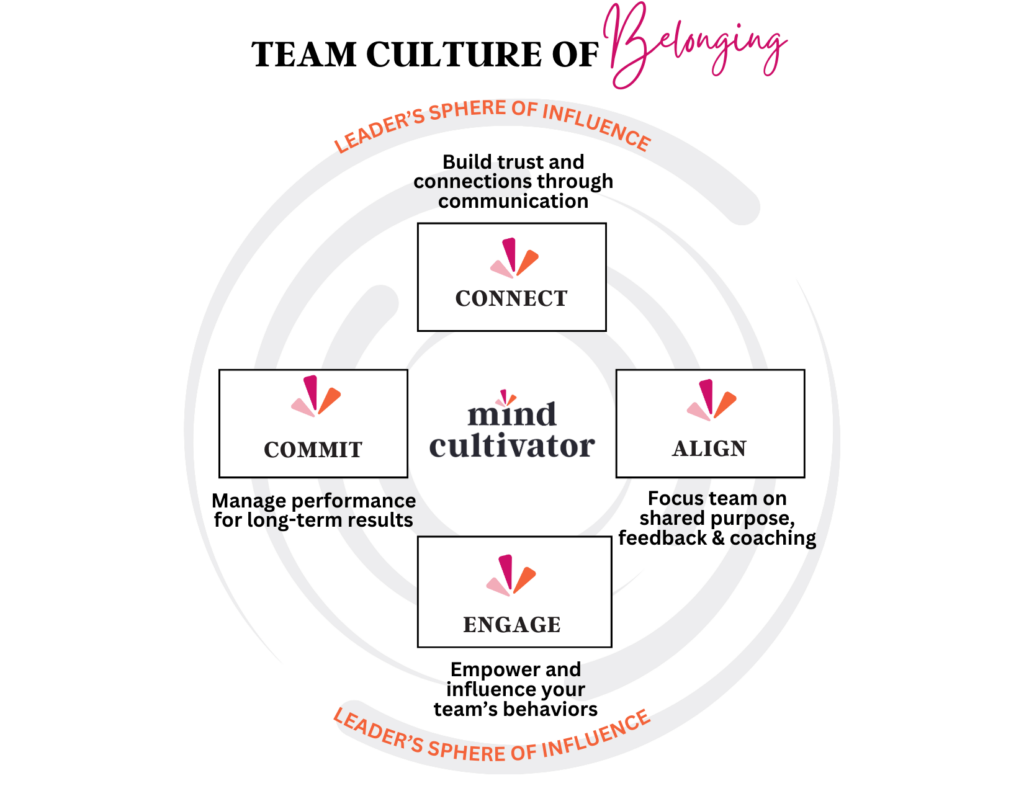
Leadership isn’t just about the title on your business card or whether you have that
coveted corner office (though it’s nice if you do!). At its core, leadership is about something far more impactful: influence. How you show up, how you impact those around you, and how you build relationships are what lead to lasting engagement and retention.
In today’s workplace, simply managing people or hitting performance targets is no longer enough. Teams want to feel valued, connected, and part of something bigger. Employees crave purpose, connection, and inclusion. And the exciting part? Leaders who create environments where people feel they truly belong inspire loyalty, drive performance, and retain top talent. This is where expanding your sphere of influence becomes a true game-changer.
Influence: More Than Just Command and Control
When we think of leadership influence, we often imagine a top-down approach, where
leaders give directives and expect compliance. But real influence is much broader—and
frankly, more nuanced—than that. It’s about the ripple effects of your actions, conversations, and even the unspoken ways you lead. It’s what you communicate through your tone, body language, and how you show up for your team, especially in those small everyday moments. Your sphere of influence isn’t just about delivering performance reviews or giving instructions. It’s how you communicate, how you listen, how you create space for others, and how you model the behaviors and values you expect from your team. Influence is about building authentic relationships that connect, engage, align, and ultimately, retain your team.
The Human Need for Belonging.
Before diving into how influence works in leadership, it’s important to understand why belonging matters so much. According to Gallup, employees who feel a strong sense of belonging are 3.5 times more likely to be engaged at work. Yet only 30% of employees globally report feeling engaged—a sobering statistic. This gap presents a golden opportunity for leaders to step in and make a real difference by fostering deeper connections and creating cultures where everyone thrives.
Belonging is more than just a buzzword; it’s a fundamental human need. Abraham Maslow’s hierarchy of needs emphasizes that after basic physical and safety needs are met, the next level of motivation is the need for love and belonging. This means humans naturally seek connection—not just in personal lives but also in professional settings.
When employees feel they belong, they are more comfortable being themselves, contributing ideas, and sharing their opinions without holding back. This leads to stronger teamwork, greater creativity, and job satisfaction.
On the other hand, employees who don’t feel that sense of belonging are 2.6 times more likely to be disengaged, according to Gallup. Disengaged employees don’t just hurt productivity; they drag down morale, safety, and quality across the team. This makes fostering belonging not just a nice-to-have but an essential leadership responsibility.
The Mind Cultivator Belonging Framework
So how can leaders effectively create this culture of belonging? This is where the Mind Cultivator Belonging Framework comes into play. Built on two decades of experience, this framework offers a tried-and-true approach to expanding your leadership influence through four key elements: Connect, Align, Engage, and Commit. When applied consistently, these elements help leaders cultivate a culture where everyone feels valued and engaged. Let’s break down how each element strengthens your sphere of influence.
1. Connect: The Currency of Leadership
Let’s start with connection—the bedrock of any leader’s influence. Teams thrive when they feel connected both to their leader and to each other. Connection is the foundation of trust, and without trust, influence is impossible.
But let’s be clear: connection goes beyond the occasional team-building exercise or a “How’s it going?” in the hallway. Real connection happens in those daily micro-moments—like asking a team member, “How are you really doing?” or showing genuine interest in their lives outside of work. It’s also about creating spaces where people feel safe to express themselves, share ideas, and even make mistakes without fear of judgment.
When leaders take the time to connect with their team personally—learning about their strengths, goals, and challenges—they build a culture of trust and recognition. Teams become more cohesive, and trust grows. And with trust comes something every leader dreams of: the willingness to go the extra mile – AKA: Employee Engagement.
The key takeaway? Engaged teams aren’t just following orders; they’re aligned with the
mission, purpose, and each other.
2. Align: Where Influence and Strategy Meet
Alignment might sound like corporate jargon, but it’s essential for keeping a team on track and united. Belonging strengthens when employees clearly see how their work contributes to the bigger picture. A leader with influence ensures that each team member understands what they’re doing and why they’re doing it.
Imagine trying to row a boat without everyone knowing the destination. Teams pull in different directions without alignment, leading to frustration and wasted effort. Leaders who align their teams help each individual see how their tasks directly contribute to organizational goals. This clarity creates a sense of purpose, and when people understand how their work makes a meaningful impact, they are far more motivated to engage deeply.
Leaders with influence don’t just tell their teams what to do—they help them see the vision, understand the strategy, and find where they fit into the bigger picture. That sense of alignment is a powerful driver of engagement and long-term commitment.
.
3. Engage: The Natural Outcome of Authentic Leadership
Once you’ve laid the groundwork for connection and alignment, engagement becomes the natural next step. Engaged employees don’t just punch the clock—they actively invest themselves in the success of the organization.
But let’s be honest: engagement can’t be forced. It’s earned through an environment where team members feel heard, respected, and empowered to contribute in meaningful ways. Leaders expand their influence by giving their teams the tools, support, and autonomy they need to thrive. This means asking for input, acting on their ideas, and recognizing wins.
The statistics here are compelling: according to Gallup, engaged employees experience 41% less absenteeism and drive 23% higher profitability. That’s no small impact. When leaders foster engagement through genuine support and growth opportunities, they’re investing directly in the success of the organization.
4. Commit: The Ultimate Result of Influence
Commitment is the holy grail of leadership. Committed teams don’t just do their jobs—they stay. Retention, the elusive dream for many leaders, comes naturally when employees feel they’re part of something meaningful, supported by a leader who truly cares.
But commitment isn’t something you extract from your team. It’s something you inspire. Leaders who are committed to their team’s development build trust and loyalty. This means holding regular check-ins, adjusting goals, and providing clear, constructive feedback. Annual reviews don’t cut it anymore. It’s about ongoing conversations that remove obstacles and help team members succeed.
When leaders commit to managing performance and addressing challenges early, they create an environment where accountability and trust thrive. This nurtures long-term commitment—an essential ingredient for driving sustainable results.
The Ripple Effect of Influence: A Leader’s Power to Shape Culture
Leadership isn’t just a top-down exercise in control. It’s a series of ripples where every action (or inaction) has an impact on your team’s culture. When leaders expand their sphere of influence—not through power plays but through authentic relationships—they create cultures of belonging where everyone feels valued and engaged.
So, the next time you reflect on your leadership style, ask yourself:
- How am I showing up today?
- What ripple effect am I creating within my team?
- Am I getting the results we need?
For leaders aiming to build a culture of belonging, the key is consistently applying the Mind Cultivator framework. By focusing on Connect, Align, Engage, and Commit, leaders expand their influence in ways that boost engagement, improve retention, and drive sustainable success.
At Mind Cultivator, we help leaders strengthen team dynamics and drive success through our Belonging Framework. We believe a leader’s sphere of influence creates the conditions for teams to CONNECT, ALIGN, ENGAGE, and COMMIT for sustainable results. To learn how our programs can transform your organization, reach out to explore more.




0 Comments